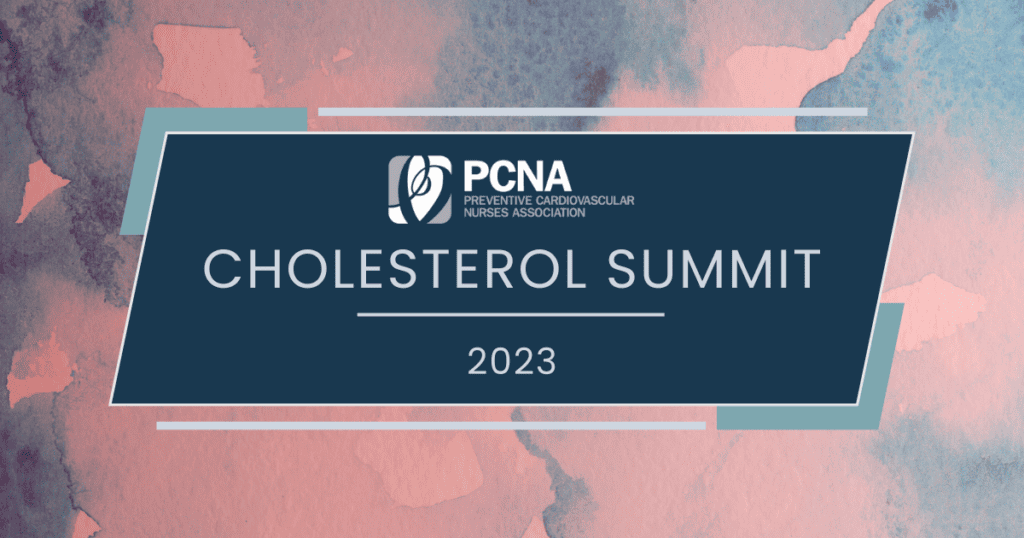The Latest Strategies in Dyslipidemia Diagnosis and Management
Dyslipidemia, the imbalance of low-density lipoprotein cholesterol (LDL-C), high-density lipoprotein (HDL), triglycerides, and other lipids, is one of the major modifiable risk factors for atherosclerosis and cardiovascular disease (CVD).1 With atherosclerosis attributed to the underlying cause of up to 50% of deaths in Westernized societies, dyslipidemia remains a significant health issue, with nurses and other healthcare professionals continuing to be at the forefront of prevention and management.2
PCNA’s 2023 Cholesterol Summit

The latest strategies in dyslipidemia diagnosis and management were the focus of PCNA’s Cholesterol Summit on May 18, 2023. Subject-matter experts shared evidence-based lipid management strategies to apply in nursing practice to address dyslipidemia. Case studies and perspectives from healthcare providers and patients provided a comprehensive overview of research and clinical practices that may be utilized to address this significant public health problem.
Kathleen Byrne, MSN, CRNP, CCRN, focused on three genetic dyslipidemias. Familial Hypercholesterolemia (FH) affects between 14-18 million people worldwide, yet it continues to be undiagnosed or underdiagnosed in 90% of those who have it. Kathleen described the importance of early diagnosis and treatment, and how barriers to diagnosis have been addressed in various locations across the globe. Kathleen also discussed the pathophysiology, diagnosis, and treatments for FH, along with the diseases of Sitosterolemia and Familial Chylomicronemia Syndrome, providing participants with case-based studies of how differential diagnosis can be applied to their clinical practice.
Megan Gwozdecke, Patient Advocate, shared her patient journey as a young adult facing the most severe form of FH, homozygous FH (HoFH). Megan discussed the impacts of her disease on her activities as a college student, and her experiences balancing the knowledge learned in the clinical setting with real-life situations. Megan also described the importance of effective patient-provider communication and shared decision-making for significant life events such as pregnancy, particularly for those with genetically transmitted diseases.
Focusing on primordial prevention of atherosclerotic CVD, Anne Goldberg, MD, FACP, FAHA, presented on how atherosclerosis starts in childhood. Implementing guideline-based medical treatment, including screening, positively impacts those at risk for, or with, FH. Dr. Goldberg discussed the efficacy of implementing early treatment on those diagnosed with FH as children, which has been shown in research to reduce atherosclerosis. Dr. Goldberg also described how healthcare providers can impact patient outcomes by engaging in actions at the individual, community, region/country, population, and global levels.
Carol Kirkpatrick, PhD, MPH, RDN, CLS, FNLA, shared how to use nutritional interventions to address adults with dyslipidemia. Dr. Kirkpatrick encouraged participants to recognize how nutritional interventions can positively influence patient health: blood pressure, A1c, cholesterol levels, and much more. Dr. Kirkpatrick described how nutrition and activity fit into the American Heart Association’s Life’s Essential Eight program, and that increasing heart-healthy foods—no matter what eating plan—can also address dyslipidemia.
Addressing women’s health across the lifespan, Eugenia Gianos, MD, reinforced the importance of risk stratification as the first step in primary prevention of dyslipidemia in women. Dr. Gianos explained the importance of CVD health in women of childbearing age: discussions of contraception methods and their impacts, assessing CVD risk prior to pregnancy, and the role of lipid screening and dyslipidemia treatment pre-conception, during pregnancy, and post-partum. Dr. Gianos also described the effects of menopause on lipoproteins.
Scientific studies over the last two decades have consistently demonstrated that ‘lower is better’ when it comes to LDL-C levels. Eileen Handberg, PhD, ANP-BC, FACC, discussed the importance of access to lipid-lowering medications in reducing the risk of CVD. Healthcare providers are tasked with helping patients reach their goals through a combination of lifestyle modifications and appropriate pharmacotherapies, keeping in mind barriers to access and effective treatment. Impacts of social determinants of health, costs of both individual and multiple prescriptions, inertia on the part of providers and patients, side effects, worry, and depression about the disease(s) are just some of the factors involved.
The program was rounded out by Sheryl Zaworski, Patient Champion, describing the difficulties in acquiring correct diagnoses and treatments for CVD-related diseases. With a strong family history of hypercholesterolemia, and personal LDL-C levels near 250, Sheryl was prescribed a statin in her 20s—but had challenges acquiring the medication when the insurance formulary would change the statins covered by her employer’s insurance plan. As she aged, some of her symptoms were misattributed to menopause/hormonal changes, and Sheryl advocated for specialized testing which revealed microvascular disease that had gone undetected in typical cardiac tests.
Dyslipidemia Resources and Additional Information
Recordings of the Cholesterol Summit will be made available by June 20, 2023, in PCNA’s online learning library. Additional dyslipidemia information is available through the following resources for both healthcare professionals and patients.
Dyslipidemia Resources for Healthcare Providers
- AHA Life’s Essential Eight
- 2019 Guideline on the Primary Prevention of CVD
- 2018 Guideline on the Management of Blood Cholesterol
- National Lipid Association
- Family Heart Foundation
- PCNA article: HoFH: Addressing Extreme LDL-C
- PCNA professional development
- PCNA podcast episode
Dyslipidemia Patient Education Resources
References
- Pappan N, Rehman A. Dyslipidemia. Stat Pearls [internet]. Treasure Island (FL): Stat Pearls Publishing; 2023 Jan. https://www.ncbi.nlm.nih.gov/books/NBK560891/. Accessed May 19, 2023.
- FH Foundation. What is Familial Hypercholesterolemia. https://thefhfoundation.org/familial-hypercholesterolemia/what-is-familial-hypercholesterolemia. Accessed 07 April 2021.
